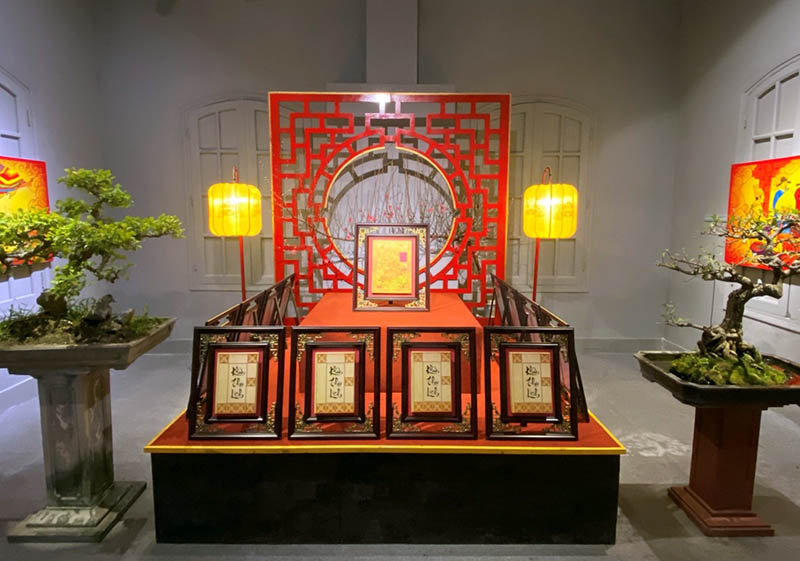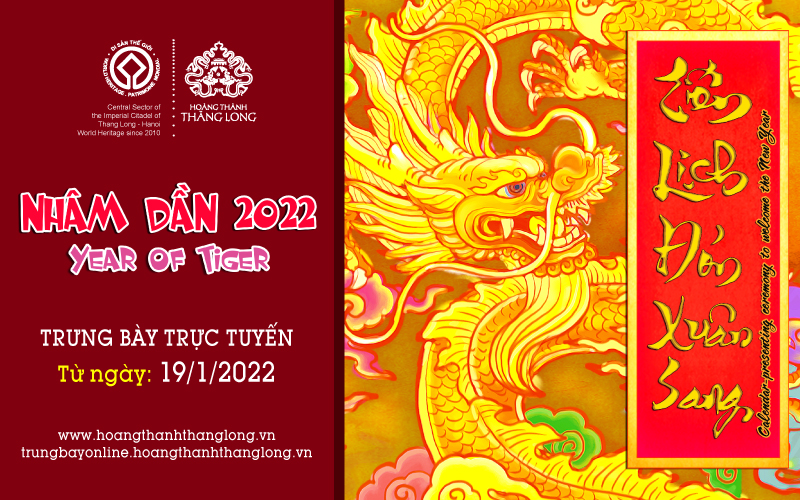Online exhibition to welcome the Lunar New Year 2022
26/01/2022
Every New Year to spring, many traditional rituals are re-enacted at the Imperial Citadel of Thang Long such as the ceremony of awakening, sealing, erecting New Year tree, calendar advancement, spring ox, put down New Year tree, opening of the seal… Welcoming the spring of the year In 2022, for the first time, the site will practice the Calendar Ceremony, a routine ritual in the ancient Le royal court.
Based on the research results, the Thang Long Heritage Conservation Center – Hanoi in collaboration with the Thang Long Cultural Heritage Preservation Association and Van Hien Company experimented with calendar activities, including 2 contents: (1) Exhibiting paintings simulating the space of the rite of passage with a model of the artifact of the cover of the book, the calendar and the process of compiling, engraving, printing, and binding the calendar. (2) Practice progressing ritual in the courtyard of Kinh Thien Palace. The ritual is recreated in the form of theatricalization, including the main scenes: The ceremony of the mandarins entering the adoration; The ritual of the Tu Thien Giam mandarin to advance to the calendar; Mandatory rituals Tradition reading system; Rituals The ceremony of the faculty of the calendar.

Under the conditions of adaptation and prevention of the Covid-19 epidemic, the heritage site has not yet opened to visitors, but activities and ceremonies at the Imperial Citadel during Tet holiday are still held in accordance with traditional rites and rituals. be filmed to promote, display online to serve a large number of tourists near and far.
On-line display with the theme “Following the Spring Festival”, recreated the space of the traditional Tet holiday with traditional customs such as wrapping banh chung, worshiping ancestors, hanging Tet pictures, Tet couplets, and wishing Tet. , ask for the first letter of the year… Especially introducing documents and pictures about the calendar making process as well as the issuance of the calendar of the Le court, simulating the cover of the book on the king’s calendar.

According to the official history, every year, in the important spring month, the court compiled a public calendar for the new year, and King Le approved it and ordered it to be engraved, printed, and bound. On December 24, at the dragon yard of Kinh Thien Palace, the court solemnly held a ceremony to bring the calendar to the emperor. Then, the king gave a calendar to the officials and people to start a year of work, successful and favorable planting.
In the Le and Tu Thien Giam dynasties (司天監) is a specialized agency in charge of astronomy and calendar, belonging to the Ministry of Ceremonies. This agency is responsible for forecasting the weather, viewing the date and time of the sand, feng shui geography and compiling the annual calendar. Calendar work was carefully conducted by Tu Thien Giam with many stages of careful comparison, censorship and approval.
According to the “Lịch triều hiến chương loại chí”, starting from February, Tu Thien Giam is responsible for looking up, calculating, and compiling the public calendar for the new year. When the manuscript was completed, it was presented to the king for approval and approval, and then ordered Trung Thu Giam to rewrite it seriously, assigning Tri Giam to take care of the writing and engraving of the woodblock. When the engraving was completed, Tu Thien Giam, the leader of the comparison, carefully reviewed each sentence, each word, each mark in both negative and positive, seeing that it was complete, then proceeded to print and arrange to close the book. At the beginning of December, choose an auspicious date and time to seal the seal and together with other specialized agencies in the Ministry of Ceremonies organize the ceremony of advancing the calendar and give calendars to mandarins from central to local levels.
The calendar advancement ceremony is described in the “Lê triều Hội điển” as follows: “On December 24, the calendar offering ceremony will be held. In the morning of that day, the princes, servants, uncles and mandarins under the orders of the king all dressed in court clothes to perform the ceremony. After the ceremony was completed, the Tu Le Giam officer brought the calendar and left it at the palace to present it to the king, then Le Khoa gave the calendar to the mandarins.
Usually there are three types of calendars: Ngu calendar has only one copy presented to the king; Quan calendar is used to bestow on public servants, martial arts officials from central to local levels. People calendar to give to the people. There are differences between the types of calendars in terms of form such as decorative motifs on the calendar cover, printing paper material, but the basic content is the same.
The ceremony of advancing the calendar and issuing the calendar showed the feudal court’s importance to the calendar making as well as its concern with the weather phenomena, climate, good date and time, the issue of weather and terrain to serve production. agriculture and daily life of the court and people.
The king, the royal family, and the court use the calendar to organize and administer the activities of the court, sacrifices, festivals, etc. The administrative work of the mandarins in the capital as well as in the local offices is based on the general schedule prescribed by the state. For the people, the role of the calendar also has a very special meaning. View the calendar to keep track of the time and weather that you farm. See the calendar to know the weather changes and respond to and prevent natural disasters…
Therefore, the rite of passage, the calendar is held very solemnly at a special time to prepare for the New Year, starting a new year with wishes of happiness, prosperity, and fullness. The calendar giving ceremony for the whole world shows the responsibility and concern of the “son of heaven” in all aspects of people’s life.
Nowadays, the study of recreating royal rituals at the Imperial Citadel of Thang Long has received the attention of researchers and visitors.
Evaluating these experimental activities, History Professor Le Van Lan said: The ceremony of entering the calendar is an important rite that has been clearly described in history books. The calendar shows the level of civilization, the method of managing the country as well as showing the authority and unity in all ceremonial, diplomatic, production and working activities of the court and the people; covering all the activities of the main court and daily life. The study and re-enactment of the calendar ceremony as well as the royal ceremonies at the Imperial Citadel of Thang Long should be promoted, in order to evoke the traditional cultural sources, to link the past and the present, between the and contemporary, thereby encouraging young people’s interest in national culture”.
You can find out more information at the Online Show “Celebrating the Spring Calendar” at: trungbayonline.hoangthanhthanglong.vn.
Center for Conservation of Imperial Citadel of Thang Long – Hanoi
RELATED ARTICLES
HERITAGES OF VIETNAM